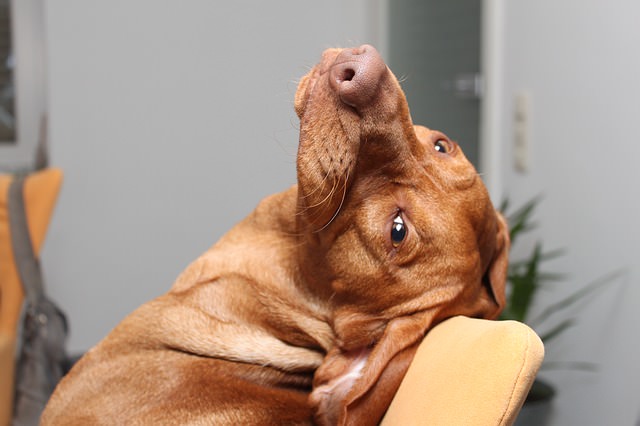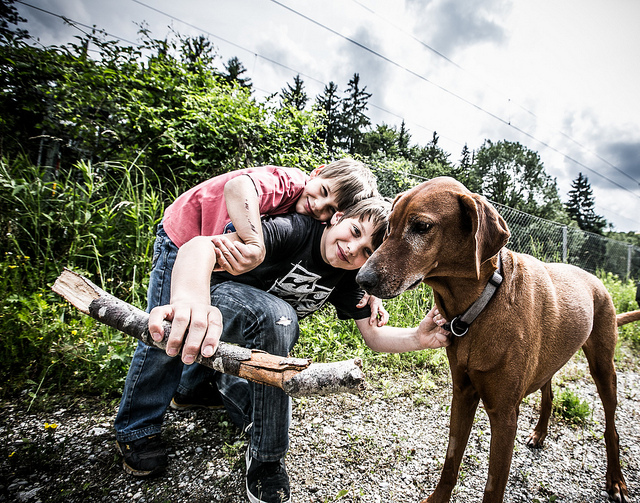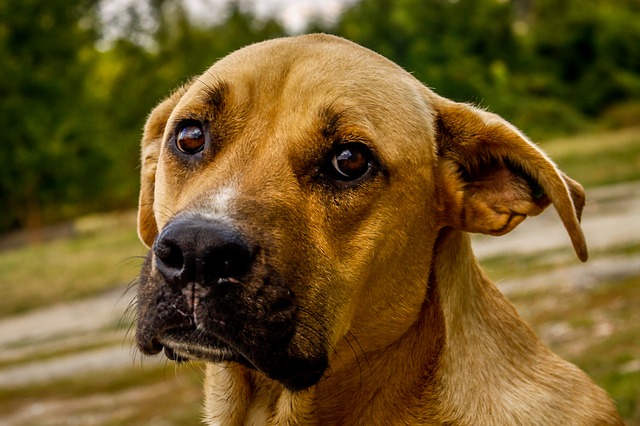When we think about our dogs and annoying behaviors, we are usually thinking about how our dogs annoy us. Perhaps it’s high time that we do some personal reflection. After all, humans can be annoying, too. If our dogs could talk, we’re sure they’d tell us a long list of ways that we aggravate, annoy and trouble them. We took a dive into human behavior to reveal some highly annoying habits of dog Moms and Dads. Avoid these behaviors to help make life a little less annoying for your dog.
NOTE: We know that all dogs are different, so one or more of these may not apply to your particular pup. But they’re all good ideas to keep in mind.

#1 – Big, Strong, Squeezy Hugs
We get it. You love your dog with all of your heart and soul. One of the ways humans communicate love is with big, strong, squeezy hugs. When humans who love each other go in for a hug, it’s a mutually satisfying experience. But have you ever hugged someone who doesn’t like to be hugged? What about someone you don’t know very well? Those hugs can be completely awkward. The hugger is being warm and affectionate while the uncomfortable recipient is stiff and a bit shocked. This is how your dog feels when you hug him.
Your dog loves you as much (or more!) as you love him. But he probably doesn’t love your hugs. Hugs are tight and constricting and make your dog feel trapped. Your dog feels dominated and wants to escape. If you have a skittish dog, this is especially true. Skittish dogs will even actively pull away from hugs. Sure, your dog may tolerate it but the fact is, he probably finds it annoying at best and threatening at worst. Save the hugs for your human loved ones and give that good boy a belly rub instead.

#2 – Idle Chit Chat
Raise your hand if you are guilty of this one. You’re cooking or tidying up, and the only ones home are you and your dog. You are chatting all about your day. You are telling your dog what you did at work, where you went out to lunch, and what you plan to do tonight to relax. Your dog loves attention from you but this kind of attention may be troublesome. Your dog listens when you speak. Closely. Why? She is looking for words or phrases that she understands.
As you blabber on about things that don’t matter to her, she is waiting for the punch line. Walk? Eat? Play? Treat? You are not saying any of those words. Your dog doesn’t want to miss a thing so she sits there, appearing to be enthralled with the details of your day. But she isn’t. She is just hoping you will eventually get to something meaningful for her. Go ahead! Chat up your companion as much as you like. But reward her for listening with something she can understand. Give her a “good girl” and head out for a walk or play session afterwards.

#3 – Scratching Your Dog’s “Spot”
Every dog has his or her own “spot.” It could be on the side, the rump, the belly, or chest. You discover it by accident. One day you are giving your dog a nice scratch down. You hit “the spot” and your dog’s skin flexes towards it, tightening up. One hind leg starts kicking, trying to scratch that imaginary itch. It’s completely involuntary. Every time you touch that spot, the same thing happens. It may seem funny to us, watching our dog get all wound up. From your dog’s perspective, however, this behavior is actually pretty annoying.
Your dog is having an involuntary reaction when he kicks and scratches his “spot.” When you activate the “spot” your dog’s nervous system springs into action. It tells your dog to scratch, kick, or bite at the source of the irritation. Horses and cows do the same thing when they swish their tail to shoo a fly from their backs. They feel something annoying and try to get rid of it. Don’t be a fly on your dog’s back.
#4 – Allowing Children to Treat Them Like Play Things
Having dogs in a home with children can be a wonderful experience for everyone involved. However, training is required on both sides. Children can do things to dogs that are irritating. If not corrected, dogs could be pushed too far, resulting in a growl or other warning. Older kids who have been taught how to behave around dogs know how to play with their dog safely. They know what the dog likes and doesn’t like. Younger or inexperienced kids? Toddlers and preschoolers? Not so much.
Children don’t mean to hurt or annoy their dogs but sometimes in the spirit of good fun, it happens nonetheless. Carrying a dog around, pushing one around in a stroller, riding or attempting to ride a dog puts a dog in physical danger. Any dog in this situation is at risk for reacting in a defensive way. Children sometimes fail to give dogs enough personal space, too. Getting in a dog’s face, moving suddenly close to a dog, or falling on a dog can all lead to trouble. The best way to avoid any unpleasant reactions on either side is to set up clear and consistent behavior boundaries between child and dog.

#5 – Brushing Against the Grain
Your dog probably sheds. Some dogs shed more than others. One of the ways to deal with the dust bunnies and sneeze-inducing dog hair floating around the house is to regularly brush or comb your dog’s fur. It’s also a nice way for you and your pup to bond and spend some time together. Sometimes we have the best intentions to help our dogs but end up failing. When you brush your dog’s hair against the grain, you are probably annoying her. Big time.
It seems like a good way to loosen up that hair and get more of it to come out in the brush instead of on your kitchen floor. We get it. The problem is, this makes your dog’s skin feel all prickly and itchy. It can even be painful for dogs with long hair. Brush or comb your pup’s hair in the direction that keeps things smooth and comforting. Your floor may be a little more covered in canine confetti but your dog will thank you.
#6 – Expecting Your Dog to Act Like a Human
We love our dogs just as fiercely as we love the humans in our life. Sometimes more! They’re family, regardless of their species. That being said, your dog is not a human. There are times when we expect our dogs to behave like humans when we really should accept their canine behavior as normal. Here’s an example.
You have a best friend, and she has a dog. Your dog and her dog are about the same size and about the same age. You want nothing more than your dogs to be best of friends. You set up time to get them together but the meeting doesn’t go well. The dogs are stand-offish or worse, they are outright aggressive toward each other. You try again and again with the same result. It’s okay! Your dog isn’t going to make friends with every dog she meets, regardless of your relationship with the other dog’s human.

#7 – Being Inconsistent or Lacking Routine
Dogs crave structure and consistency from their humans and lives. When they know what you expect of them, they deliver. When they get meals, play time, exercise, and sleep in a predictable order and timeframe day after day, they feel confident, happy, and secure. Of course, life can be unpredictable and no-one can walk their dog every single day at the same time without fail. The point is, providing structure can promote the security needed to be okay even when the routine gets broken some days.
Dogs like to know the rules. They will do what they can to follow them in order to please you. The key is to enforce the rules consistently. If one of your rules is no feeding from the table, you cannot ever give your dog a bite of food from the table. Further, you cannot let anyone else do it either. If you don’t want your dog on your bed, you can’t let is slide while you are sick in bed and then get mad the next time he jumps up there. Choose your rules and follow them, not matter the circumstance.
#8 – Assuming Your Dog Understands the Value of Objects
Your dog has toys that he can rip up, chew to bits, and drag through the dirt. They bring him joy and stimulate his brain. In short, they are great fun! He hears you cheering him on. He sees you throwing the ball. He delights in you pulling the other end in a game of tug of war. One time, though, you came home after he’d found himself a new toy.
Your brand new shoes, your kid’s new stuffed animal, a remote control…something caught his eye, was available, and he tore it to bits. But for some reason, you got mad at him this time! There was no cheering or clapping, just an angry face and a “bad boy.” This is terribly confusing for a dog. If your dog has access to an object, there is the potential that he will take advantage of that. He is not trying to hurt you. He’s just being a dog. Keep valuable objects away from your dog and save both of you plenty of annoyance and heartache.
We know you would never annoy your precious pup on purpose! Keep these things in mind that may annoy or bother your dog and help your pup stay cool, calm and comfortable.
 Toledo, United States.
Toledo, United States.